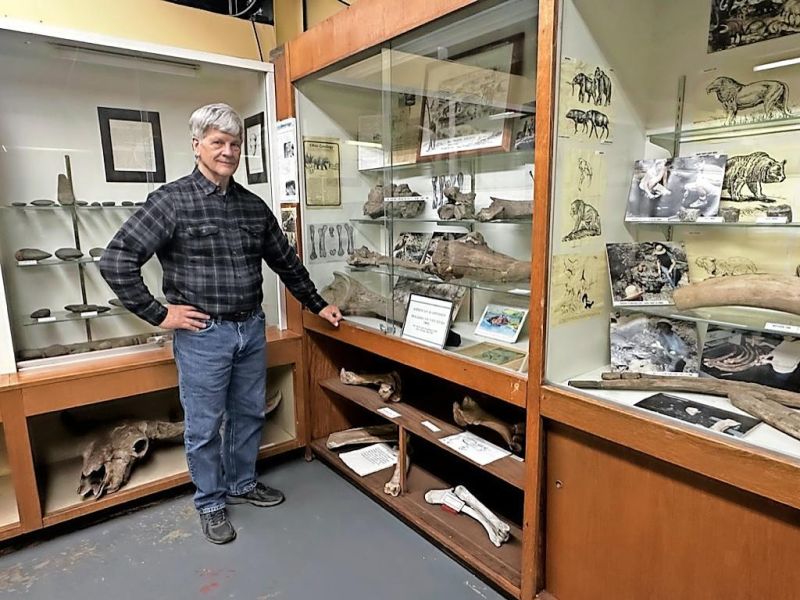Brush to talk Ice Age at Killbuck Valley Museum
Dr. Nigel Brush will return to Killbuck to present “Ice Age Animals” in the Exploring the Deep Past of Holmes County series. The presentation will take place Thursday, Aug. 14 at the Duncan Theater in Killbuck, catacorner from the Killbuck Valley Museum.
Patrons of this free event are invited to explore the Killbuck Valley Museum two hours before the presentation to see the Martins Creek mastodon material and other exciting new additions to the museum’s collection.
“This is an exciting presentation for us because Nigel brings such a wealth of knowledge and intriguing discussion on the Ice Age,” said Bob Porter, president of Killbuck Valley Museum.
Brush is a 1969 graduate of West Holmes High School and has a PhD in anthropology from UCLA.
Since 1982, he has been one of the nation’s top archaeologists and has been conducting archaeological and geological field work in Holmes, Wayne and Coshocton counties, including two mastodon sites and six late prehistoric village sites in the Walhonding Valley area. Other field work includes exploring 30 rock shelters in the Killbuck Valley.
Brush is a professor emeritus of geology at Ashland University and an affiliated scholar in the archaeological program and department of anthropology and sociology at The College of Wooster.
He brings with him an extensive knowledge of Holmes County’s deep past and will share some of the incredible findings and replicas in the newest addition to the Killbuck Valley Museum collection.
Killbuck Valley Museum better be careful if it wants to keep its moniker as Holmes County’s best-kept secret, because its most recent summer addition to its collection of natural and cultural history items should be a real drawing card.
This past spring, Brush enhanced what was already a fascinating natural and historical collection. Brush introduced his unique assemblage that was formerly featured as part of the “Science on Display” collection in the Kettering Center at Ashland University.
“It’s a fantastic collection, and we are excited to be able to have it as part of our museum,” Porter said.
Complete with rocks, meteorites, Pleistocene fossils and bones from eons ago, the new addition to the museum will undoubtedly fascinate those who venture inside.
Brush said the rocks in the display are carbon dated at more than 1 billion years old and are all metamorphic because the only rocks that can survive that length of time are buried well below the Earth’s surface.
The display includes nine different types of rock, all of which tell the story of the glacial activity that rolled in through Canada and into North America, eventually stopping and depositing much of the material that got caught up inside the glacier right here in the Holmes and Wayne counties area.
The rock display paints a vivid picture of all the various types of stones from the period of that glacier activity and portrays the incredible beauty that history has left behind for people to enjoy.
However, perhaps the items that will draw the most attention from visitors are the addition of more mastodon bones that enhance the mastodon display that already existed.
The bones, teeth, vertebrae and tusks showcase the mammoth size of these ancient beasts. In addition, there are several unique replica skulls of other animals from a long bygone era.
“These types of skulls that are real finds are extremely rare,” Brush said of animals like the sabretooth American Lion, sabretooth cats and a giant 10-foot-tall ground sloth, the latter of which was found years ago in Berlin.
Brush famously excavated two local geological sites where mastodon remains were discovered, and some of those finds have resided in the Killbuck Valley Museum for many years. However, in adding this new collection, Brush’s discoveries take on a whole new light.
“This really is a spectacular addition to our museum,” Porter said. “The work Nigel has done is so important to telling the story of our past. He has always been such a big part of our museum, and now we have probably the finest mastodon collection this side of the Cleveland Museum of History.”
Killbuck Valley Museum is located on Front Street in Killbuck and is open May 1-Oct. 31 Saturdays and Sundays from 1-4 p.m. It is also available for group tours on other days, which can be made by appointment by calling Porter at 330-763-0133. Admission is by donation.

